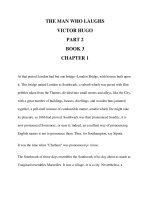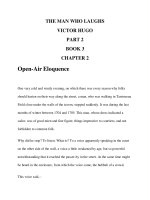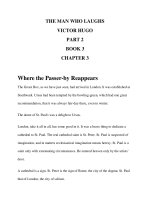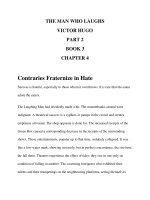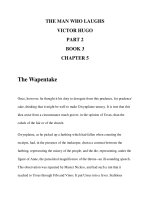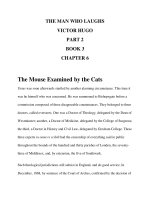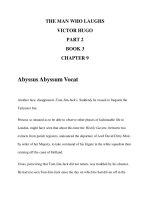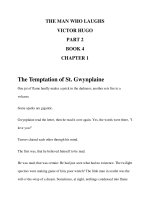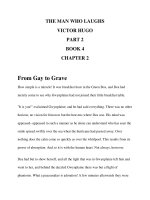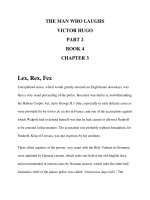THE MAN WHO LAUGHS VICTOR HUGO PART 2 BOOK 3 CHAPTER 1 doc
Bạn đang xem bản rút gọn của tài liệu. Xem và tải ngay bản đầy đủ của tài liệu tại đây (16.61 KB, 6 trang )
THE MAN WHO LAUGHS
VICTOR HUGO
PART 2
BOOK 3
CHAPTER 1
At that period London had but one bridge London Bridge, with houses built upon
it. This bridge united London to Southwark, a suburb which was paved with flint
pebbles taken from the Thames, divided into small streets and alleys, like the City,
with a great number of buildings, houses, dwellings, and wooden huts jammed
together, a pell-mell mixture of combustible matter, amidst which fire might take
its pleasure, as 1666 had proved. Southwark was then pronounced Soudric, it is
now pronounced Sousouorc, or near it; indeed, an excellent way of pronouncing
English names is not to pronounce them. Thus, for Southampton, say Stpntn.
It was the time when "Chatham" was pronounced je t'aime.
The Southwark of those days resembles the Southwark of to-day about as much as
Vaugirard resembles Marseilles. It was a village it is a city. Nevertheless, a
considerable trade was carried on there. The long old Cyclopean wall by the
Thames was studded with rings, to which were anchored the river barges.
This wall was called the Effroc Wall, or Effroc Stone. York, in Saxon times, was
called Effroc. The legend related that a Duke of Effroc had been drowned at the
foot of the wall. Certainly the water there was deep enough to drown a duke. At
low water it was six good fathoms. The excellence of this little anchorage attracted
sea vessels, and the old Dutch tub, called the Vograat, came to anchor at the Effroc
Stone. The Vograat made the crossing from London to Rotterdam, and from
Rotterdam to London, punctually once a week. Other barges started twice a day,
either for Deptford, Greenwich, or Gravesend, going down with one tide and
returning with the next. The voyage to Gravesend, though twenty miles, was
performed in six hours.
The Vograat was of a model now no longer to be seen, except in naval museums. It
was almost a junk. At that time, while France copied Greece, Holland copied
China. The Vograat, a heavy hull with two masts, was partitioned perpendicularly,
so as to be water-tight, having a narrow hold in the middle, and two decks, one fore
and the other aft. The decks were flush as in the iron turret-vessels of the present
day, the advantage of which is that in foul weather, the force of the wave is
diminished, and the inconvenience of which is that the crew is exposed to the
action of the sea, owing to there being no bulwarks. There was nothing to save any
one on board from falling over. Hence the frequent falls overboard and the losses
of men, which have caused the model to fall into disuse. The Vograat went to
Holland direct, and did not even call at Gravesend.
An old ridge of stones, rock as much as masonry, ran along the bottom of the
Effroc Stone, and being passable at all tides, was used as a passage on board the
ships moored to the wall. This wall was, at intervals, furnished with steps. It
marked the southern point of Southwark. An embankment at the top allowed the
passers-by to rest their elbows on the Effroc Stone, as on the parapet of a quay.
Thence they could look down on the Thames; on the other side of the water
London dwindled away into fields.
Up the river from the Effroc Stone, at the bend of the Thames which is nearly
opposite St. James's Palace, behind Lambeth House, not far from the walk then
called Foxhall (Vauxhall, probably), there was, between a pottery in which they
made porcelain, and a glass-blower's, where they made ornamental bottles, one of
those large unenclosed spaces covered with grass, called formerly in France
cultures and mails, and in England bowling-greens. Of bowling-green, a green on
which to roll a ball, the French have made boulingrin. Folks have this green inside
their houses nowadays, only it is put on the table, is a cloth instead of turf, and is
called billiards.
It is difficult to see why, having boulevard (boule-vert), which is the same word as
bowling-green, the French should have adopted boulingrin. It is surprising that a
person so grave as the Dictionary should indulge in useless luxuries.
The bowling-green of Southwark was called Tarrinzeau Field, because it had
belonged to the Barons Hastings, who are also Barons Tarrinzeau and Mauchline.
From the Lords Hastings the Tarrinzeau Field passed to the Lords Tadcaster, who
had made a speculation of it, just as, at a later date, a Duke of Orleans made a
speculation of the Palais Royal. Tarrinzeau Field afterwards became waste ground
and parochial property.
Tarrinzeau Field was a kind of permanent fair ground covered with jugglers,
athletes, mountebanks, and music on platforms; and always full of "fools going to
look at the devil," as Archbishop Sharp said. To look at the devil means to go to
the play.
Several inns, which harboured the public and sent them to these outlandish
exhibitions, were established in this place, which kept holiday all the year round,
and thereby prospered. These inns were simply stalls, inhabited only during the
day. In the evening the tavern-keeper put into his pocket the key of the tavern and
went away.
One only of these inns was a house, the only dwelling in the whole bowling-green,
the caravans of the fair ground having the power of disappearing at any moment,
considering the absence of any ties in the vagabond life of all mountebanks.
Mountebanks have no roots to their lives.
This inn, called the Tadcaster, after the former owners of the ground, was an inn
rather than a tavern, an hotel rather than an inn, and had a carriage entrance and a
large yard.
The carriage entrance, opening from the court on the field, was the legitimate door
of the Tadcaster Inn, which had, beside it, a small bastard door, by which people
entered. To call it bastard is to mean preferred. This lower door was the only one
used, It opened into the tavern, properly so called, which was a large taproom, full
of tobacco smoke, furnished with tables, and low in the ceiling. Over it was a
window on the first floor, to the iron bars of which was fastened and hung the sign
of the inn. The principal door was barred and bolted, and always remained closed.
It was thus necessary to cross the tavern to enter the courtyard.
At the Tadcaster Inn there was a landlord and a boy. The landlord was called
Master Nicless, the boy Govicum. Master Nicless Nicholas, doubtless, which the
English habit of contraction had made Nicless, was a miserly widower, and one
who respected and feared the laws. As to his appearance, he had bushy eyebrows
and hairy hands. The boy, aged fourteen, who poured out drink, and answered to
the name of Govicum, wore a merry face and an apron. His hair was cropped close,
a sign of servitude.
He slept on the ground floor, in a nook in which they formerly kept a dog. This
nook had for window a bull's-eye looking on the bowling-green.
